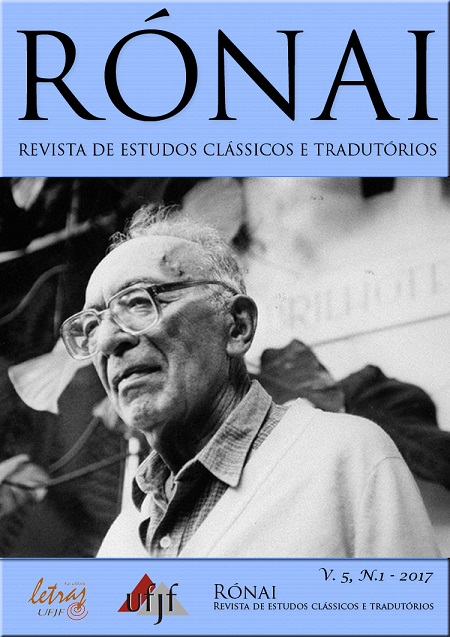Intertextuality and the rhetorical canon
DOI:
https://doi.org/10.34019/2318-3446.2017.v5.23208Keywords:
literary art, criticism, intertextuality, canon, rhetoricAbstract
Starting form an etymological history of the terms "rhetoric" and "canon", the article addresses the interdependence of methods and means between literary art (production and criticism) and the traditional rhetorical system that has been at the basis of European education since Antiquity. Intertextuality is recognized as a "universal literary constant," pointing out the ways in which formal (particularly British) teaching in the Middle Ages and in the Renaissance played a central role in validating the literary canon. In the end, ways to evaluate, decode and relativize the rhetorical tradition in the context of modern criticism are pointed out, emphasizing that the process of deconstruction should not imply the dismantling of structures, but a conscious manifestation of each one of them.
Downloads
References
BALDWIN, T. W. William Shakespeare's Small Latine and Lesse Greeke. Urbana: University of Illinois Press, 1944. 2 v.
BARON, H. Humanistic and Political Literature in Florence and Venice at the Beginning of the Quattrocento. Cambridge: Harvard University Press, 1955a.
______. The Crisis of the Early Italian Renaissance: Civic Humanism and Republican Liberty in an Age of Classicism and Tyrany. Princeton: Princeton University Press, 1955b. 2 v.
BATE, W. J. The Burden of the Past and the English Poet. Cambridge: Belknap Press, 1970.
BUSH, D. Mythology and the Renaissance Tradition in English Poetry. Minneapolis: University of Minnesota Press, 1932.
ELYOT, S. T. The Book Named The Governor. Londres: Dent, 1907.
ERASMO. The Collected Works of Erasmo. Toronto: University of Toronto Press, 1974.
FUMAROLI, M. L’Âge de l'éloquence : Rhetorique et 'res literaria' de la Renaissance au seuil de l'époque classique. Geneva: Droz, 1980.
GORDAN, P. W. G. Pro Renaissance Book Hunters: The Letters of Poggius Bracciolini to Nicolaus de Niccolis. New York: Columbia University Press, 1974.
GREENE, T. M. The Light in Troy: Imitation and Discovery in Renaissance Poetry. New Haven: Yale University Press, 1982.
HENDERSON, J. R. Erasmus on the Art of Letter Writing. In: MURPHY, J. J. (Org.). Renaissance Eloquence: Studies in Theory and Practice of Renaissance Rhetoric. Berkeley: University of California Press, 1983.
HOFSTADTER, D. R. Godel, Escher, Bach: An Eternal Golden Braid New York: Vintage Book, 1979.
JUNG, C. G.; KERÉNYI, K. Essays on a Science of Mythology. New York: Pantheon, 1948, passim — com referências fornecidas por eles.
KENNEDY, G. A. Classical Rhetoric and Its Christian and Secular Tradition from Ancient to Modern Times. Chapel Hill: University of North Carolina Press, 1980.
KERMODE, F. The Genesis of Secrecy. Cambridge: Harvard University Press, 1976.
KLEIN, R. In: Formand Meaning: Essays on the Renaissance and Modern Art.. New York: Viking Press, 1979.
KRISTELLER, P. O. Renaissance Thought and Its Sources. New York: Columbia University Press, 1979.
LARUSSO, D. A. Rhetoric in the Italian Renaissance. In: MURPHY, J. J. Renaissance Eloquence: Studies in the Theory and Practice of Renaissance Rhetoric. Berkeley: University of California Press, 1983.
MAN, P. de. Blindness and Insight: Essays in the Rhetoric of Contemporary Criticism. New York: Oxford University Press, 1971.
MCFARLAND, T. Literature and Philosophy. In: BARRICELLI, J.-P. (Org.). Interrelations of Literature. New York: Modern Language Association of America, 1982.
MILLER, J. H. Stevens' Rock and Criticism as Cure, II. Georgia Review, v. 30, 1976.
MOSS, J. (Org.) Rhetoric and Praxis. New York: Catholic University of America Press, 1986.
MURPHY, J. J. Renaissance Rhetoric: A Short-Title Catalogue. New York: Garland, 1981.
_______. Renaissance Eloquence: Studies in the Theory and Practice of Renaissance Rhetoric. Berkeley: University of California Press, 1983.
POCOCK, J. G. A. Politics, Language, and Time. New York: Atheneum, 1971.
SCHANZ, H. Problems and Trends in the History or German Rhetoric to 1500. In: MURPHY, J. J. Renaissance Eloquence: Studies in the Theory and Practice of Renaissance Rhetoric. Berkeley: University of Calilfornia Press, 1983.
SCHOECK, R. J. On Rhetoric in Fourteenth-Century Oxford. Medieval Studies, Toronto, v. 30, 1968.
______. The Achievement of Thomas More. Victoria: University of Victoria, 1976.
______. Review of Murphy’s Renaissance Rhetoric: A Short-Title Catalogue, in English Language Notes, v. 21, 1981.
VICKERS, B. (Org.). Rhetoric Revalued: Papers from the International Society for the History of Rhetoric. Medieval and Renaissance Texts and Studies, Arizona: Arizona State University, 1982.
______. Lighting a Candle to the Place: On the Dimensions and Implications of Imitatio in the Renaissance. Italian Culture, Abingdon, v. 4, 1983.
______. Modern European Intellectual History. Denver Quarterly Review, Denver, v. 19, 1984.
VINSAUF, G. de. Poetria Nova. Trad. Margaret Nims. Toronto: Pontifical Institute of Mediaeval Studies, 1967, p. 16-17.
WILLIAMS, R. Keywords: A Vocabulary of Culture and Society. New York: Oxford University Press, 1976.
Downloads
Published
How to Cite
Issue
Section
License
Copyright (c) 2017 Richard Joseph Schoeck

This work is licensed under a Creative Commons Attribution 4.0 International License.
Copyright
The authors of the published contributions agree with the following items:
1. The authors keep the copyright and convey to the journal the right of first publication, the work being licensed under a Creative Commons Attribution License 4.0 International.
2. The authors are allowed and stimulated to publicize and distribute their work online after the publication in the journal, recognizing first publication in this journal.
3. The authors of the approved works authorize the journal to distribute their content, after publication, for reproduction in content indexes, virtual libraries and similars.
For more information about Creative Commons Attribution License 4.0 International, please, go to: https://creativecommons.org/licenses/by/4.0/deed.en
Editorial exemption
The authors of the published contributions are entirely and exclusively responsible for their contents. Its content does not represent an official position of Rónai - Revista de Estudos Clássicos e Tradutórios neither of Faculdade de Letras da Universidade Federal de Juiz de Fora or their partner institutions.



